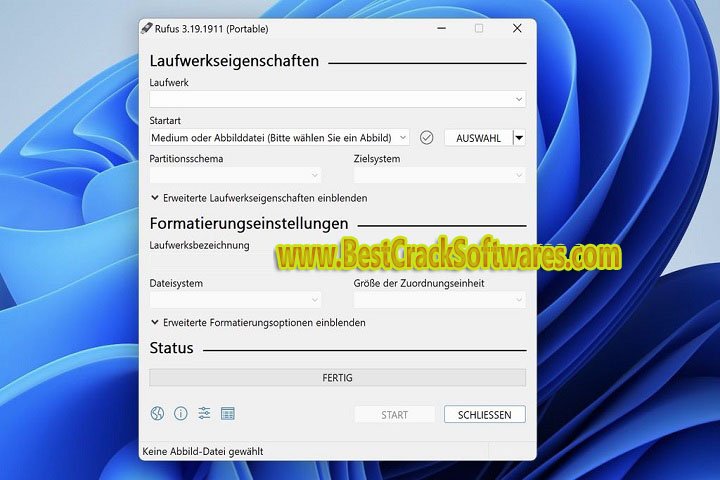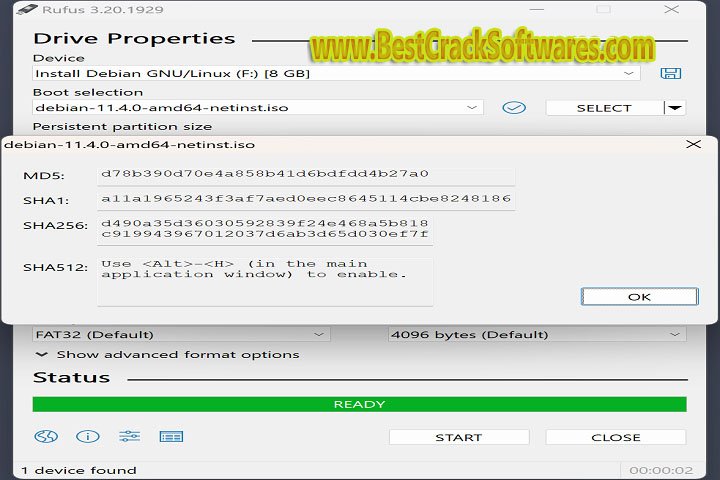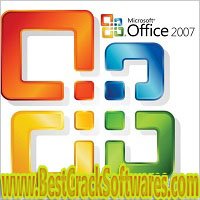Rufus 3.20 Pc Software
Rufus 3.20 Pc software
In the ever-evolving field of software programs, it stands as a brilliant beacon for a specific and vital duty: generating bootable USB sticks. This lightweight yet powerful tool has garnered tremendous appeal among computer fans and IT experts due to its simplicity, reliability, and remarkable feature set.

In this detailed essay, we will go into an in-depth overview of it , study its important features, probe into its technical setup details, and explain the system requirements to ensure a seamless user experience.
You may also like this :: Abelssoft JetDrive 9.5 Pc Software
Rufus 3.20 Software Overview
Rufus is free and open-source utility software built primarily for producing bootable USB devices from various ISO images. It’s a versatile program that has received accolades for its user-friendly interface and effectiveness in producing bootable media for installing or repairing operating systems. Rufus has become a go-to solution for customers who seek a quick and dependable technique to prepare USB sticks for various purposes, such as installing Windows, Linux distributions, or BIOS updates.
Rufus 3.20 Key Features
**1. User-Friendly Interface:** Rufus is noted for its straightforward and easy user interface. Even individuals with minimal technological experience can utilize the software with ease. The simple design focuses on functionality without additional complexity.
**2. Wide Compatibility:** Rufus supports a wide range of ISO images, including Windows installation files, Linux distributions, rescue CDs, and several other bootable tools. This broad interoperability makes it a valuable tool for a range of activities.
**3. Fast and Reliable:** It s is designed to be fast and reliable. It uses complex algorithms to improve the writing process on USB devices, guaranteeing that bootable media is written rapidly and without mistakes.

**4. Partition Schemes and File Systems: The software lets users choose from several partition schemes (MBR, GPT) and file systems (FAT32, NTFS, and more) depending on their unique needs and the destination system’s requirements.
**5. Bad Sector Handling:** It is packed with technologies that can manage USB drives with faulty sectors, guaranteeing reliable bootable disc generation even with slightly damaged drives.
6. Portable Application: It doesn’t require installation; it can operate as a standalone portable application. This means you may take it on a USB stick and use it on any Windows computer without leaving any traces behind.
7. Multilingual assistance: The software includes multilingual assistance, making it accessible to users around the world.
Rufus 3.20 Software Technical Setup Details
### Installation
One of the noteworthy qualities of it is its simplicity when it comes to installation. Since it’s a portable application, you don’t need to install it on your machine. You can obtain the current version of Rufus directly from the official website or reputable software repositories. Once downloaded, you can start the executable file, and the software is ready to use.
### User Interface
Rufus boasts a basic and user-friendly layout. When you run the application, you are confronted with a straightforward window that offers all the required options for generating a bootable USB drive. The key elements of the user interface include:

– **Device:** This part allows you to select the USB disk you want to use for making the bootable media.
**Boot Selection:** Here, you can choose the ISO image or other bootable files you want to use.
**Partition Scheme:** Choose between MBR (Master Boot Record) and GPT (Guid Partition Table) based on your requirements.
File System: Select the file system for the USB drive, such as FAT32, NTFS, or UDF.
**Cluster Size:** Customize the cluster size for the file system.
**Volume Label:** Set a name for the bootable drive.
**Format Options:** Advanced formatting options, including faulty sector handling.
**Start:** Initiates the bootable media generation procedure.
### Creating a Bootable USB Drive with Rufus
Using Rufus to generate a bootable USB device is a basic process:
1. Insert your USB drive: Plug in the USB drive that you want to use for producing the bootable media. Ensure it’s correctly detected by your computer.
2. Launch Rufus: Run the Rufus application by double-clicking the executable file.
3. Select the USB drive: In the “Device” dropdown, choose your USB drive from the list of accessible devices.
4. Choose an ISO image: In the “Boot Selection” area, click on “Select” and choose the ISO image or bootable files you want to use.
5. Configure settings: Set the partition scheme, file system, cluster size, and volume label according to your requirements.
6. Start the procedure: Click the “Start” button to commence the bootable media creation process. Rufus will display a warning saying that all data on the USB drive will be deleted. Ensure you have backed up any crucial data on the drive before starting.
7. **Confirmation:** Rufus will ask for confirmation to write in ISO Image mode. Click “OK” to begin.
8. Creation process: Rufus will begin formatting the drive and copying the ISO image to it. This process may take some time, depending on the size of the ISO file and the speed of your USB device.
9. **Completion:** Once the operation is complete, Rufus will display a “READY” state, indicating that your bootable USB device is ready for use.
You may also like this :: Driver Easy 5.8.1.41398 Pc Software
Rufus 3.20 Software System Requirements
To ensure a smooth experience with Rufus 3.20, your system should match the following minimal requirements:
Operating System: Rufus is compatible with Windows operating systems, including Windows 7, Windows 8, Windows 8.1, and Windows 10. It may not be compatible with non-Windows operating systems.

– **Processor:** A recent x86 or x64 processor is recommended for best performance.
– **RAM:** Rufus is a lightweight application that doesn’t have tight RAM requirements. However, having at least 1GB of RAM is advised.
– **Storage:** Rufus itself requires very minimal storage space, but you will need additional space for the ISO images you wish to utilize for producing bootable media.
**USB Drive:** You’ll need a USB device with sufficient capacity to hold the ISO image or bootable files you wish to utilize. A 4GB or bigger USB drive is usually sufficient for most applications; however, the required capacity will depend on the exact ISO image.
You may also like this :: TMS VCL UI Pack V 12 0 1 0 PC Software
Rufus 3.20 Conclusion
Rufus 3.20 has reinforced its reputation as a trustworthy, user-friendly, and feature-rich application for manufacturing bootable USB devices. Whether you’re installing a new operating system, fixing a computer, or generating a rescue disk, Rufus simplifies the process and assures that your bootable media is made without a hitch. Its versatility, interoperability, and speed make it an invaluable utility for IT professionals and computer fans alike. With its modest system requirements, it’s accessible to a wide spectrum of users, and its open-source nature promises continued improvement and community support. Rufus 3.20 genuinely empowers your PC by giving you the ability to generate bootable discs with ease and confidence.
Download Link : Mega
Your File Password : BestCrackSoftwares.com
File Version 3.20 & Size : 1 MB
File type : Compressed / Zip & RAR (Use 7zip or WINRAR to unzip File)
Support OS : All Windows (32-64Bit)
Upload By : Somia Saleem
Virus Status : 100% Safe Scanned By Avast Antivirus



